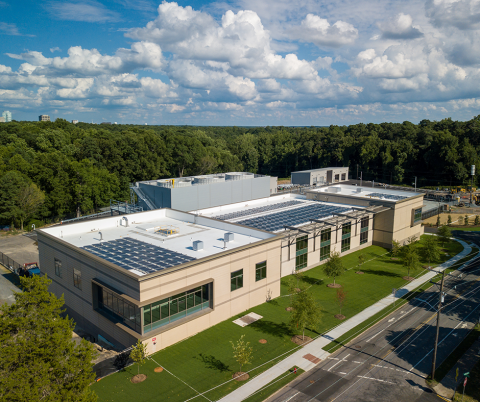Duke University Chiller Plant Aquifer Thermal Energy Storage Assessment (2024-2025)
Background
Since the release of Duke’s first Climate Action Plan in 2009, campus leaders have been working to develop sustainable solutions to a range of campus operations, including campus energy use. The 2022 Duke University Climate Commitment, launched a university-wide, impact-oriented initiative to address the climate crisis by creating sustainable and equitable solutions placing the university on the path towards carbon-neutrality. The Climate Commitment builds upon foundations of climate and sustainability efforts throughout campus operations, academics, research and engagement.
To reach the goal of carbon neutrality set out in the Duke Climate Commitment, Duke must consider more sustainable, cost-effective ways to heat and cool water, which according to the Duke Office of Sustainability, accounts for about half of campus energy usage.
Aquifer Thermal Energy Storage (ATES) Systems represent one promising sustainable energy supply for heating and cooling buildings. ATES systems store and retrieve thermal energy from underground water sources by taking advantage of the natural properties of the earth to store excess heat or coolness from buildings or industrial processes for later use.
Project Description
This project team will determine the thickness and cost-effective Aquifer Thermal Energy Stage utilization of rocks beneath three Duke University Chiller Plants. Fractured and porous rocks, essential for ATES, are projected to underlie both Duke University campus and Durham. The team will core drill and geophysically log 300-meter-deep wells close to the plant evaporation towers.
ATES systems consist of several wells to store residual warm and cold water currently produced as waste energy by Chiller Plants. Team members will study the characteristics and distributions of the subsurface rocks to determine water storage and retrieval capacity. The team will design hydrogeological studies and models of ATES hot and cold-water storage potential. Hydrogeological studies include tests to determine the bulk and local permeability of subsurface formations, as well as the overall storage capacity. Team members will work to understand the heat transfer in these wells and their underground connections.
If the thickness of identified rocks extends for meters vertically and laterally, they may have potential for use in ATES cooling and heating at Duke University. Extrapolated to Durham, such findings can influence Durham's development for energy efficient buildings, apartments and houses, especially for communities that suffer disproportionately from weather extremes. The assessments determine fluid-flow characteristics and distribution for air conditioning and heating water storage.
Anticipated Outputs
Aquifer Thermal Energy Storage usage at Duke and in Durham; community partnerships; archival exhibit; data for grant proposals; blog posts; business plan; peer-reviewed publication; website
Student Opportunities
Ideally, this project team will include 9 graduate students and 6 undergraduate students with skills and interests in earth science, geochemistry, environmental engineering, geology, civil engineering, policy, economics, communication and journalism.
Students on the team will obtain real world experience in energy resource characterization and optimization. Students will do hands-on material characterization of the extracted core samples and will learn about resource design and optimization. Students will gain experience in research reporting, academic writing, field drilling, geophysical log handling and compilation, data collection and analysis, and operational, economic and environmental modeling.
Select team members will travel to the American Geophysical Union meeting in San Francisco, California in December 2024.
Timing
Fall 2024 – Spring 2025
- Fall 2024: Begin weekly course lectures; prepare for Aquifer Thermal Energy Storage drilling assessments; participate in hands-on drilling; collect data and begin log; review assessment results; travel to American Geophysical Union meeting in San Francisco
- Spring 2025: Continue weekly course lectures; perform research reviews; continue hands-on drilling and data collection; interpret results; write publication
Crediting
Academic credit available for fall and spring semesters
See earlier related team Duke University Central Campus Geothermal Test (2023-2024).
Image: Duke’s Chiller Plant No. 3, on Anderson St., by Bill Snead/Duke University

Team Leaders
- Laura Dalton, Pratt School of Engineering-Civil & Environmental Engineering
- Peter Malin, Nicholas School of the Environment-Earth and Climate Sciences
- Danilo Meyer-Arrivillaga, Nicholas School of the Environment–Earth and Climate Sciences–Ph.D. Student
- Manolis Veveakis, Pratt School of Engineering-Civil & Environmental Engineering
/yfaculty/staff Team Members
-
Paul Baker, Nicholas School of the Environment-Earth and Climate Sciences
-
Emily Bilcik, Office of Sustainable Duke
-
Casey Collins, Duke Facilities Management
-
Henri Gavin, Pratt School of Engineering-Civil & Environmental Engineering
-
Heileen Hsu-Kim, Pratt School of Engineering-Civil & Environmental Engineering
-
Brian McAdoo, Nicholas School of the Environment-Earth and Climate Sciences
